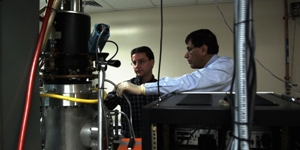Aug 11 2010
Total knee and hip joint replacement devices that last a lifetime are closer to reality thanks to recent breakthroughs in Department of Physics laboratories at the University of Alabama at Birmingham involving specialized nanodiamonds a billionth of a meter in size.
The work was jump-started last year by a grant from the National Institute of Arthritis and Musculoskeletal and Skin Diseases, part of the federal National Institutes of Health, to physicist Yogesh Vohra, Ph.D., director of the UAB Center for Nanoscale Materials and Biointegration, and Aaron Catledge, Ph.D., a research assistant professor of physics at UAB.
 UAB physicists Aaron Catledge, Ph.D., and Yogesh Vohra, Ph.D., have adhered a self-designed nanodiamond coating to the metal most commonly used in hip and knee joint replacement devices, which could extend allow the devices to last a lifetime.
UAB physicists Aaron Catledge, Ph.D., and Yogesh Vohra, Ph.D., have adhered a self-designed nanodiamond coating to the metal most commonly used in hip and knee joint replacement devices, which could extend allow the devices to last a lifetime.
Since getting the grant, Vohra and Catledge have worked to refine a process to adhere a self-designed coating to cobalt chromium, the metal most commonly used in joint replacement devices. The coating consists of very small diamonds called nanodiamonds.
“Imagine taking an engagement ring and shrinking it to a point where it is one 10-thousandth of your human hair, yet it is still a perfect crystal. That is what we are talking about,” Vohra says.
The nanodiamond coating is tough, yet smooth; so once adhered to the metals of a joint implant device, it’s intended to last for the life of the device – all the while reducing friction and saving wear and tear on the joint replacement’s moving parts.
Vohra says around 700,000 hips and knees are replaced in the United States each year, but most devices last only a little longer than 10 years on average. This leads to repeat procedures, and the deterioration of the devices in the body also can cause health problems when small pieces of the implants break off and impact surrounding tissue and bone.
“Over time the implants get loose and you start hearing those squeaking sounds. After five to 10 years you have to replace that joint again,” Vohra says. “Our goal of this research is really to make surfaces that will literally last forever and overcome this problem.”
The research team is closer than ever to reaching that goal. After much trial and error, specialized screening machines have verified both the nanodiamond coating structure and its ability to adhere to the metal of joint devices.
“The nanodiamond film is sticking now,” Catledge says. “We want to put the technology in extended wear tests, see the measurements and show industry that there are good benefits for the use of the nanodiamond coating on cobalt chromium alloy.”
Under its NIH grant, the UAB team has a research partnership Smith and Nephew Inc. that allows them access to the company’s hip and knee simulators, which will offer the team access the most realistic testing conditions to date for their coating technology. Neither of Vohra or Catledge have a financial stake in the partnership.
Performance testing could begin by the late fall. Catledge and Vohra say commercialization of their nanodiamond coating to improve the service life of joint replacement devices could be as close as a few years away.
Source: http://www.uab.edu/